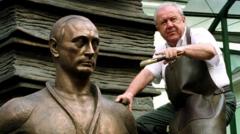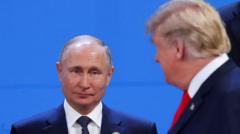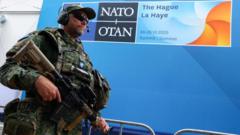Zurab Tsereteli, known for his grand sculptures and close ties to Russian politics, has died, leaving a controversial yet impactful legacy in the art world.
Zurab Tsereteli, Iconic Georgian-Russian Artist, Passes Away at 91

Zurab Tsereteli, Iconic Georgian-Russian Artist, Passes Away at 91
The renowned artist and sculptor's legacy is defined by monumental works and polarizing public opinion.
Georgian-Russian artist Zurab Tsereteli, famed for his enormous and often debated monuments, has passed away at the age of 91. Born in Tbilisi, Tsereteli made a name for himself with his towering creations, including the colossal 98-meter (321ft) statue of Tsar Peter the Great in Moscow, a ruler notorious for his disdain of the city he helped establish.
Rising to prominence during the Soviet era, Tsereteli was the lead designer for the 1980 Olympic Games in Moscow and went on to create large sculptures around the globe. His strong rapport with the Russian political elite was evident, with Tsereteli expressing that he felt inspired to craft a bronze likeness of Vladimir Putin, calling it a reflection of the president's "healthy soul."
His friendship with former Moscow mayor Yuri Luzhkov provided him with an influential platform, enabling him to travel abroad and engage with other iconic artists such as Pablo Picasso during his visits to Paris. Tsereteli's impact was acknowledged by Russian Foreign Ministry spokeswoman Maria Zakharova, who described him as "an artist of world renown," whose works would endure in the hearts of many.
The controversial reception of his art often sparked fierce debates; for instance, the enormous Peter the Great statue faced criticism from some residents of Moscow in 2010. However, Tsereteli earned respect in the art community, serving as the president of the Russian Academy of Arts. His monumental works can be viewed internationally, including a commemorative statue of Christopher Columbus in Seville, Spain, and the Tear of Grief monument in New Jersey, which honors the victims of the 9/11 attacks.
Another significant piece by Tsereteli, Good Defeats Evil, is located at the UN Headquarters in New York, symbolizing the triumph over nuclear conflict through the historical treaty between the US and the Soviet Union. His controversial works sometimes ignited disputes, such as the 2006 erection of a large bronze statue of Pope John Paul II in France, which faced backlash due to its implications on French secularism.
One of his tallest achievements, the monument Birth of the New World, commemorates Columbus's first voyage and stands at 110m (360ft) in Puerto Rico, after several potential sites in the US declined its installation. Tsereteli's expertise was not limited to sculptures, as he was also a painter and architect who played a pivotal role in restoring Moscow's Cathedral of Christ the Saviour.
Among his more intimate creations were bronze studies of significant figures such as Princess Diana and Putin, showcasing both his artistic versatility and his engagement with notable contemporary themes.




















